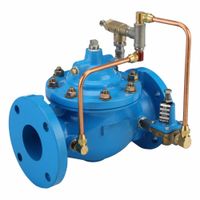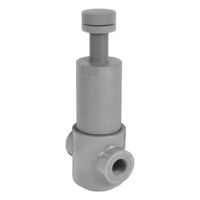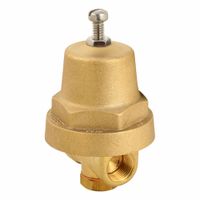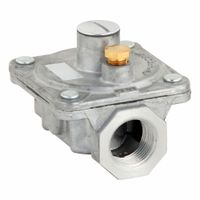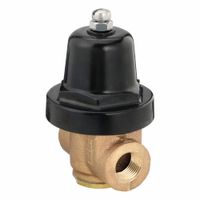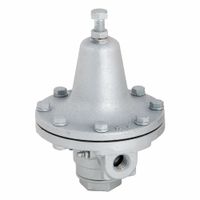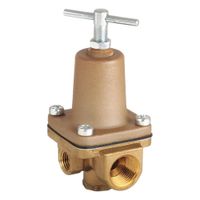Call +(254) 703 030 000 / 751 483 999 / 721 704 777
- Home
- Plumbing
- Plumbing Valves
- Pressure Temperature Control Valves
- Pressure Regulators
Pressure Regulators
Pressure regulators control the incoming pressure of water, steam, gas, and other media to a desired level. General purpose pressure regulators maintain consistent fluid pressure supplied to downstream equipment and processes. Water pressure regulators maintain consistent water pressure levels throu .....Read More
Frequently Asked Questions
What is a pressure regulator and how does it work?
A pressure regulator is a device designed to maintain a constant output pressure from a variable input pressure. It is commonly used in gas and liquid systems to ensure that the downstream pressure remains within a desired range, regardless of fluctuations in the upstream pressure or changes in flow demand.
The basic components of a pressure regulator include a pressure-reducing element, a sensing element, and a control element. The pressure-reducing element, often a valve, reduces the input pressure to the desired output pressure. The sensing element, typically a diaphragm or piston, detects changes in the downstream pressure. The control element, usually a spring, adjusts the position of the valve based on the feedback from the sensing element.
When the downstream pressure drops below the set point, the sensing element detects this change and causes the control element to open the valve, allowing more fluid to pass through and increase the pressure. Conversely, if the downstream pressure exceeds the set point, the sensing element signals the control element to close the valve, reducing the flow and lowering the pressure.
Pressure regulators can be direct-acting or pilot-operated. Direct-acting regulators use a spring-loaded diaphragm to control the valve position directly. Pilot-operated regulators use a pilot valve to control a larger main valve, allowing for more precise control and handling of higher flow rates.
Overall, pressure regulators are essential for protecting equipment, ensuring safety, and maintaining process efficiency by providing stable pressure control in various applications, including industrial, medical, and domestic systems.
How do you adjust a pressure regulator?
1. **Identify the Regulator Type**: Determine if it's a single-stage or dual-stage regulator, as the adjustment process may vary slightly.
2. **Safety First**: Ensure all equipment is turned off and depressurized. Wear appropriate safety gear, such as gloves and goggles.
3. **Locate the Adjustment Knob**: Find the adjustment knob or screw on the regulator. This is usually located on the top or side of the regulator.
4. **Check the Current Pressure**: Use a pressure gauge to determine the current outlet pressure. This will help you know how much adjustment is needed.
5. **Adjust the Pressure**:
- **Increase Pressure**: Turn the adjustment knob clockwise. This will increase the outlet pressure.
- **Decrease Pressure**: Turn the adjustment knob counterclockwise. This will decrease the outlet pressure.
6. **Monitor the Gauge**: As you adjust, keep an eye on the pressure gauge to ensure you reach the desired pressure level.
7. **Fine-Tune**: Make small adjustments to fine-tune the pressure to the exact level required.
8. **Lock the Setting**: If the regulator has a locking mechanism, secure the adjustment to prevent accidental changes.
9. **Test the System**: Turn on the equipment and test the system to ensure it operates correctly at the new pressure setting.
10. **Recheck and Readjust if Necessary**: After testing, recheck the pressure and make any additional adjustments if needed.
11. **Document the Change**: Record the new pressure setting for future reference and maintenance.
12. **Regular Maintenance**: Periodically check and adjust the regulator to ensure optimal performance and safety.
What are the different types of pressure regulators?
Pressure regulators are devices used to control and maintain a desired pressure level in a system. The different types include:
1. **Direct-Operated Regulators**: These are simple devices where the pressure adjustment is achieved through a spring-loaded diaphragm. They are suitable for low-flow applications and are often used in household appliances.
2. **Pilot-Operated Regulators**: These regulators use a pilot valve to control the main valve. They are more complex and suitable for high-flow applications, providing more precise control over pressure.
3. **Back Pressure Regulators**: These maintain a set pressure upstream of the regulator. They are used to control pressure in systems where excess pressure needs to be relieved.
4. **Pressure-Reducing Regulators**: These reduce the input pressure to a lower, stable output pressure. They are commonly used in gas distribution systems.
5. **Vacuum Regulators**: These control the pressure in vacuum systems, maintaining a set vacuum level.
6. **Dome-Loaded Regulators**: These use a gas pressure in a dome to control the output pressure. They are used in applications requiring high flow rates and precise control.
7. **Electronic Pressure Regulators**: These use electronic controls to adjust pressure, offering high precision and the ability to integrate with automated systems.
8. **High-Pressure Regulators**: Designed to handle very high input pressures, these are used in industrial applications like gas cylinders.
9. **Low-Pressure Regulators**: Used for applications requiring low output pressures, such as in some laboratory settings.
10. **Specialty Regulators**: Designed for specific applications, such as corrosive environments or high-purity systems.
Each type of regulator is chosen based on the specific requirements of the application, including the desired pressure range, flow rate, and environmental conditions.
What are the common applications of pressure regulators?
Pressure regulators are essential components in various applications across different industries. Here are some common applications:
1. **Gas Distribution Systems**: Pressure regulators are used to control the pressure of gases like natural gas, propane, and oxygen in residential, commercial, and industrial gas distribution systems, ensuring safe and efficient delivery.
2. **Medical Equipment**: In medical devices such as oxygen tanks and anesthesia machines, pressure regulators maintain the correct pressure for safe and effective patient care.
3. **Welding and Cutting**: Regulators are crucial in welding and cutting operations to control the flow and pressure of gases like acetylene and oxygen, ensuring precision and safety.
4. **HVAC Systems**: In heating, ventilation, and air conditioning systems, pressure regulators help maintain optimal pressure levels for efficient system performance and energy savings.
5. **Automotive Industry**: Fuel pressure regulators in vehicles ensure the correct fuel pressure is maintained for optimal engine performance and fuel efficiency.
6. **Aerospace and Aviation**: Pressure regulators are used in aircraft systems to manage cabin pressure and fuel systems, ensuring safety and comfort.
7. **Chemical and Petrochemical Industries**: These industries use pressure regulators to control the pressure of various chemicals and gases in processing plants, ensuring safe and efficient operations.
8. **Water Systems**: In water supply systems, pressure regulators help maintain consistent water pressure, preventing damage to pipes and fixtures.
9. **Laboratory Equipment**: Pressure regulators are used in laboratory settings to control the pressure of gases in experiments and analytical instruments.
10. **Food and Beverage Industry**: Regulators are used in carbonation processes and to control the pressure of gases in packaging and dispensing systems.
These applications highlight the versatility and critical role of pressure regulators in ensuring safety, efficiency, and precision across various sectors.
How do you troubleshoot a pressure regulator?
1. **Identify Symptoms**: Note any irregularities such as fluctuating pressure, leaks, or unusual noises.
2. **Check Installation**: Ensure the regulator is installed correctly, with the flow direction matching the arrow on the body.
3. **Inspect for Damage**: Look for physical damage, corrosion, or debris on the regulator and connected components.
4. **Verify Pressure Settings**: Confirm that the pressure settings are correct and adjust if necessary.
5. **Examine Inlet Pressure**: Ensure the inlet pressure is within the regulator's specified range.
6. **Check for Blockages**: Inspect for blockages in the inlet and outlet ports, and clean if needed.
7. **Test for Leaks**: Use a soap solution to check for leaks around connections and seals.
8. **Assess Diaphragm and Springs**: Disassemble the regulator to inspect the diaphragm and springs for wear or damage.
9. **Evaluate Venting**: Ensure the vent is not blocked and is functioning properly.
10. **Monitor Output Pressure**: Use a pressure gauge to verify the output pressure is stable and within the desired range.
11. **Review Maintenance Records**: Check past maintenance records for recurring issues or patterns.
12. **Consult Manufacturer’s Manual**: Refer to the manual for specific troubleshooting steps and specifications.
13. **Replace Components**: If necessary, replace worn or damaged parts such as seals, diaphragms, or springs.
14. **Reassemble and Test**: Reassemble the regulator and test it under normal operating conditions to ensure proper function.
15. **Seek Professional Help**: If issues persist, consult a professional technician or the manufacturer for further assistance.
What are the signs of a failing pressure regulator?
Signs of a failing pressure regulator include:
1. **Fluctuating Water Pressure**: Inconsistent water pressure, with sudden increases or decreases, indicates the regulator is not maintaining a steady flow.
2. **Noisy Plumbing**: Unusual noises such as banging, knocking, or whistling in the pipes can result from a malfunctioning regulator causing pressure surges.
3. **Water Hammer**: This is a specific type of noise caused by a sudden stop in water flow, often due to high pressure from a failing regulator.
4. **Leaking Fixtures**: Excessive pressure can cause leaks in faucets, showerheads, or other fixtures, as they are unable to handle the increased force.
5. **High Water Bills**: A failing regulator may lead to higher water usage due to leaks or increased flow, resulting in unexpectedly high water bills.
6. **Dripping Faucets**: Persistent dripping, even when faucets are turned off, can be a sign of excessive pressure from a faulty regulator.
7. **Shortened Appliance Lifespan**: Appliances like water heaters, dishwashers, and washing machines may wear out faster due to the stress of high water pressure.
8. **Visible Regulator Damage**: Physical damage, corrosion, or wear on the regulator itself can indicate it is failing and needs replacement.
9. **Inconsistent Shower Temperature**: Fluctuating water pressure can lead to sudden changes in shower temperature, making it difficult to maintain a consistent setting.
10. **Low Water Pressure**: In some cases, a failing regulator may restrict water flow too much, resulting in low pressure throughout the home.
11. **Pressure Gauge Readings**: If equipped, a pressure gauge showing readings outside the normal range (usually 40-60 psi for residential systems) can indicate a problem with the regulator.
How do you select the right pressure regulator for a specific application?
1. **Determine Application Requirements**: Identify the type of gas or liquid, flow rate, inlet and outlet pressure, temperature, and environmental conditions.
2. **Material Compatibility**: Ensure the regulator materials are compatible with the fluid to prevent corrosion or degradation.
3. **Pressure Range**: Choose a regulator with an appropriate pressure range for both inlet and outlet pressures. It should handle maximum and minimum pressures effectively.
4. **Flow Requirements**: Select a regulator that can maintain desired flow rates without causing excessive pressure drop.
5. **Type of Regulator**: Decide between single-stage or dual-stage regulators. Single-stage is suitable for applications with stable inlet pressures, while dual-stage is better for fluctuating pressures.
6. **Accuracy and Sensitivity**: Consider the precision needed for the application. High-precision applications may require more sensitive regulators.
7. **Size and Port Configuration**: Ensure the regulator fits the system's size and has the correct port configuration for easy integration.
8. **Temperature Range**: Verify that the regulator can operate within the system's temperature range without performance issues.
9. **Safety Features**: Look for features like pressure relief valves or lockout mechanisms for added safety.
10. **Regulatory Compliance**: Ensure the regulator meets industry standards and certifications relevant to the application.
11. **Cost and Maintenance**: Consider the initial cost, maintenance requirements, and availability of spare parts.
12. **Manufacturer Reputation**: Choose a reputable manufacturer known for quality and reliability.
13. **Consultation**: If unsure, consult with a specialist or the manufacturer for recommendations based on specific needs.
